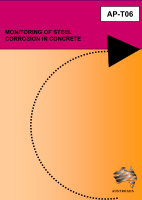Bridges

Monitoring of Steel Corrosion in Concrete
- Publication no: AP-T06-00
- ISBN: 0 85588 577 7
- Published: 1 January 2000
- PDF (free) Download
Concrete is the dominant material of construction in the more than 12,000 bridges and major culverts managed by road authorities in Australia and New Zealand. With an ageing asset, concrete durability is becoming an increasingly significant issue for bridge owners. Corrosion monitoring can reveal the onset or progression of reinforcement damage in concrete structures, provide the basis for adopting appropriate prevention measures and provide data for service life prediction. A number of techniques of corrosion monitoring have been used in the laboratory and the field. The report provides a critical review of current measuring and monitoring techniques, including their limitations and future improvements.
- 1. Introduction
- 2. Corrosion processes and monitoring of parameters
- 2.1. Processes involved in the corrosion of reinforcement
- 2.1.1. Anodic Reaction
- 2.1.2. Cathodic Processes
- 2.1.3. Other Important Processes and Factors
- 2.2. Parameters associated with corrosion processes
- 2.2.1. Corrosion characteristic parameters
- 2.2.2. Electrochemical parameters
- 2.2.3. Non-electrochemical parameters
- 2.3. Basic monitoring procedures
- 3. Half-cell potential
- 3.1. Premises
- 3.1.1. Theoretical prerequisites
- 3.1.2. Technical preconditions
- 3.1.3. Conversion of half-cell potential into corrosion activity
- 3.1.4. Half-cell potential mapping
- 3.2. Technical requirements
- 3.3. Advantages and disadvantages
- 3.3.1. Advantages
- 3.3.2. Disadvantages
- 3.4. Applications and recent development
- 4. Polarisation resistance
- 4.1. Principle
- 4.1.1. Stern-Geary principle
- 4.1.2. Theoretical prerequisites
- 4.1.3. Technical preconditions
- 4.1.4. Conversion of Rp into corrosion rate
- 4.2. Advantages and disadvantages
- 4.3. Equipment and Sensorised Guard ring
- 4.4. Application and development
- 5. Polarisation curve technique
- 5.1. Principle
- 5.1.1. Theoretical and experimental polarisation curves
- 5.1.2. Obtaining corrosion rate
- 5.2. Technical requirements
- 5.3. Advantages and disadvantages
- 5.3.1. Advantages:
- 5.3.2. Disadvantages:
- 5.4. Applications
- 6. AC electrochemical impedance spectroscopy
- 6.1. Basic principles
- 6.2. Technical requirements
- 6.3. Typical Equivalent Circuits
- 6.4. Typical EIS Spectra
- 6.5. Advantages and disadvantages
- 6.5.1. Advantages
- 6.5.2. Disadvantages:
- 6.6. Applications
- 7. Transient responses
- 7.1. Principle
- 7.2. Technical requirements
- 7.3. Advantages and disadvantages
- 7.3.1. Advantages:
- 7.3.2. Disadvantages:
- 7.4. Applications
- 8. Galvanic Corrosion current
- 8.1. Principle
- 8.1.1. Galvanic current
- 8.1.2. Galvanic sensor
- 8.2. Technical requirements
- 8.3. Advantages and disadvantages
- 8.3.1. Advantages
- 8.3.2. Disadvantages
- 9. Electrochemical Noise
- 9.1. Principle
- 9.2. Technical requirements
- 9.3. Advantages and disadvantages
- 10. Monitoring of non-electrochemical parameters
- 10.1. Resistivity of Concrete
- 10.2. Chloride content
- 10.3. Carbonation of concrete
- 10.4. Moisture content
- 10.5. Other Physical Techniques
- 11. Combination of various techniques
- 12. Summary of current monitoring techniques
- References
Related publications
ABC2022-110-22
Latest Bridges News
